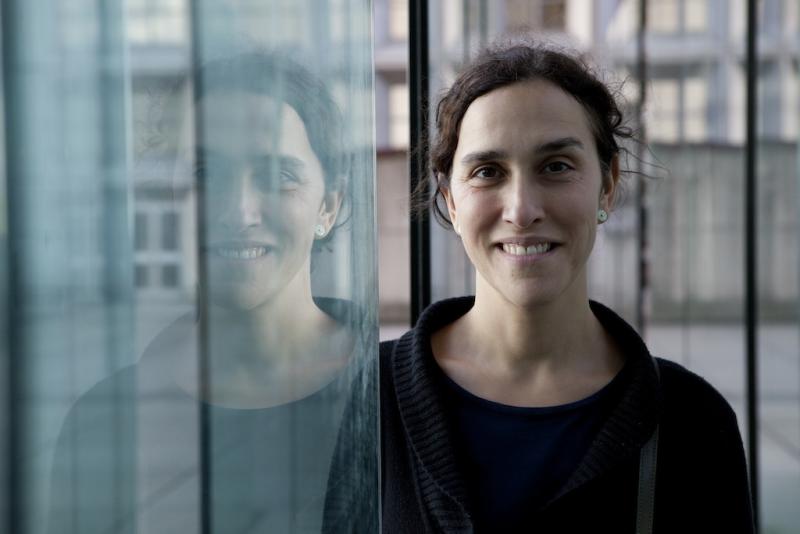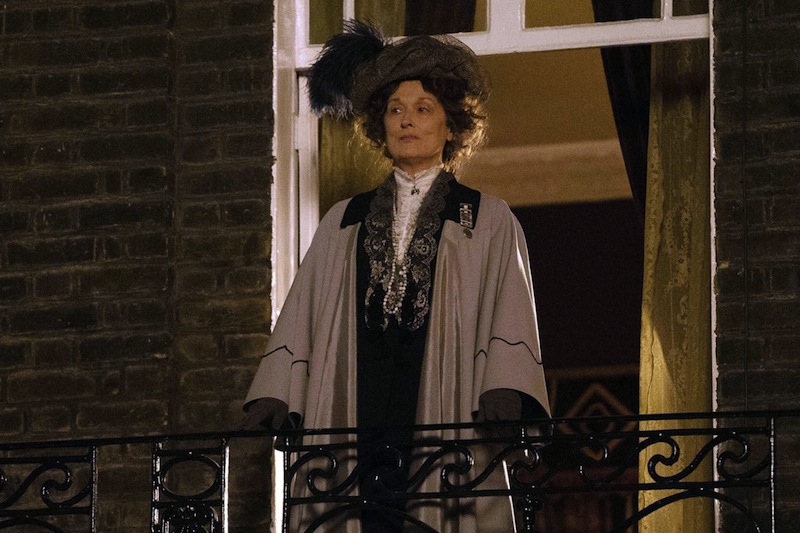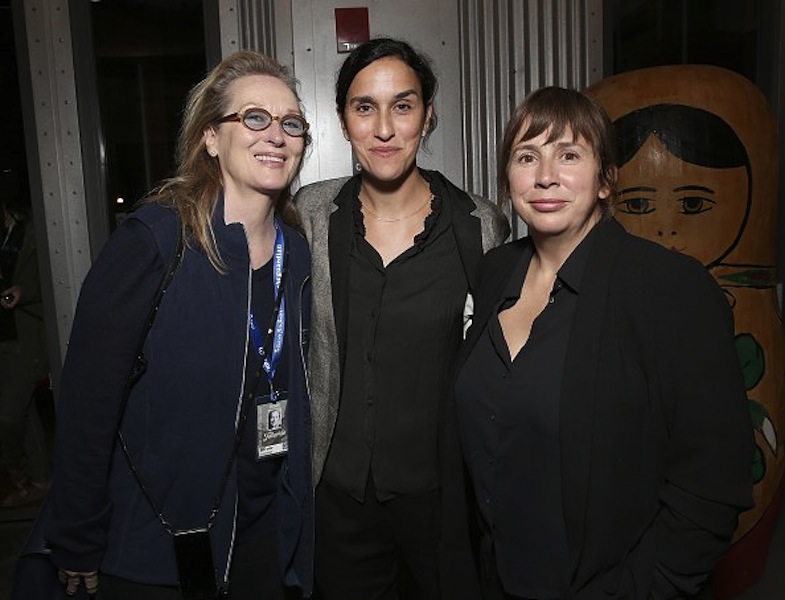10 Questions for Director Sarah Gavron | reviews, news & interviews
10 Questions for Director Sarah Gavron
10 Questions for Director Sarah Gavron
As Suffragette opens the London Film Festival, its director reflects on a group of women ahead of their time

Director Sarah Gavron tends to make films with strong social content. Her TV movie This Little Life (2003) concerned a couple’s struggles after the premature birth of their son; her first feature film was an adaptation of Monica Ali’s novel Brick Lane (2007) about two Bangladeshi sisters, one confined to an arranged marriage that takes her to London, the other eloping in a "love marriage" in Bangladesh.
It’s no real surprise, then, that Gavron’s second feature is Suffragette; moreover, she’s no mere director for hire, but one of the group of women filmmakers who conceived of the idea to bring the suffragette story to the screen and spent the past five years achieving it.
Together they’ve dusted away the obfuscating image of dainty women in nice hats petitioning and making speeches, to reveal the tougher, more brutal, yet also inspiring truth about the lengths to which British women actually went to achieve suffrage. The behind-the-scenes team includes acclaimed screenwriter Abi Morgan (Brick Lane, The Iron Lady, The Hour), while on camera Carey Mulligan leads an extraordinary ensemble that includes Helena Bonham Carter, Anne-Marie Duff, Romola Garai, Natalie Press and a certain Meryl Streep, who follows her portrayal of one formidable Briton, Margaret Thatcher, with a lady of an altogether different stripe, Emmeline Pankhurst.
Impeccably made and, Streep notwithstanding, British to the core, Suffragette is an apt choice to open the London Film Festival. It’s on general release from Monday 12 October.

DEMETRIOS MATHEOU: Why did you want to make a film about the suffragettes?
SARAH GAVRON: I learned very little about the suffragettes at school. What I knew in my teens was the Mary Poppins, sanitised version. So when I learned the true story and started researching it, I was amazed. I was struck by how ahead of their time the suffragettes were. They were breaking all the taboos and conventions of that society. These women went to such extreme lengths to achieve their rights, and lost so much in the process – their homes, their families, their children. The bombing and attacks on property, the brutality of the police response, imprisonment, hunger-striking and being force fed, it felt very much like an untold story.
It also felt like a story that resonated with what is happening around the world today, in so many countries, not just in terms of gender inequality, but inequality generally and the activism of people who are challenging repression. It’s a timely, necessary reminder of how far we’ve come, but also how far we’ve still got to go.
So how did you become aware of that militant side of the movement?
Bits and pieces. I re-watched Shoulder to Shoulder, a BBC series dramatising the suffragette movement in 1975, by Mitch McKenzie, which actually made a big impression on a generation of women but then got forgotten. The series hinted at the violence and the brutality, which pointed me in that direction.
Almost more striking was when we went to the archives of the Museum of London and found the suffragettes’ unpublished letters, memoirs and prison diaries. The suffragettes were very aware of their legacy. And their voices feel so contemporary. They were talking about the gender pay gap, abuses in the workplace, custodial rights, as well as documenting their fear and exhilaration, the feeling of camaraderie in being part of a movement. This was the sort of material that is often reduced to two or three lines in mainstream history books.
 Tell me about the decision to focus not on the Pankhursts, but the working women of the movement.
Tell me about the decision to focus not on the Pankhursts, but the working women of the movement.
We didn’t get there initially, we sort of circled those characters. Abi Morgan wrote Maud [played by Carey Mulligan pictured left] as a smaller character in one of the drafts. Then we suddenly thought that hers is really the story we should be telling, especially if we want this story to connect with people today. Had we focused on the Pankhursts it would have been the story of exceptional women, and an examination of power as well as the issues. But what we wanted was to tell the story of women with no platform, no entitlement, and to see what drove those people to activism. Working people are often at the vanguard of change, but in the shadows of history. We wanted to shine a light on these ones.
Another thing that was interesting was that there were working class women in the movement who worked alongside the upper and middle class women we’ve tended to hear about. Even in the apartheid class system of Edwardian Britain, they did come together.
There’s a brilliant story about Lady Constance Lytton, who was arrested, but as an aristocrat in prison was not treated like her fellow suffragettes. So the next time she was demonstrating she disguised herself as a working woman – cut her hair and wore working clothes – and got treated terribly. Class was a huge factor, which is rarely looked at in history and rarely looked at in film and stories around the movement.
The other key decision is the timing. 1912 was when they escalated their militant action.
Yes. Militancy officially began in 1905, when Christabel Pankhurst was grabbed at a public meeting for daring to ask a question first and, when she was taken out by a policeman, spat at him. She was arrested and taken to prison, and that was talked about as the first act of militancy. And it escalated from there. But in 1912 they changed their tactics and started window-smashing and then attacking property. We chose that period because it was when militancy was at its height, but also because it shows a story of a woman who joins at that moment, so it’s a way of observing a very particular journey to activism.
I think it’s important to understand why people turn to civil disobedience, and what inequality does to people. It’s astounding to see the lengths people will go to when treated unfairly. But looking at this political movement and others, I’d say it’s always a multiplicity of actions that achieve change. Sadly, yes, often people have turned to more violent tactics, but what the peaceful action achieved – the grassroots campaigning, the petitioning – shouldn’t be undervalued. And many of those who turned to militancy had been engaged with peaceful petitioning for many years.
 When you are only featuring Pankhurst briefly, you want someone who can make a quick impression. In casting Meryl Streep [pictured right], were you actually thinking ‘an icon for an icon’?
When you are only featuring Pankhurst briefly, you want someone who can make a quick impression. In casting Meryl Streep [pictured right], were you actually thinking ‘an icon for an icon’?
We did actually. She’s only in this one scene, but she’s playing this charismatic leader who was being seen through the eyes of working women, who appears and lights up their lives and lights up the screen for that one sequence. So we thought we wanted an icon to play an iconic character, to have that weight and power for that one moment in the film. It was Carey Mulligan who suggested Meryl. She was incredibly generous with her time and her attitude, and she’s been a great ambassador for the project. in fact, she’s a great advocate for women in the film industry and beyond.
Cinema is one of the more high-profile workplaces in which women experience inequality.
If you look at the statistics, there’s no doubt that it’s an imbalanced environment. It’s kind of shocking that just 10% of films each year are directed by women – so more than 90% are by men. And there are too few female protagonists in films.
For me it was all about finding role models. When I was in my early twenties and just working out if I dared to become a director, I was given confidence by seeing the work of Jane Campion, Mira Nair, Clare Denis, Sally Potter – and later Kathryn Bigelow and others. The minute I saw women directors I felt confident about putting myself forward. It definitely takes a lot of confidence.
I found some fantastic champions in making this project, financiers and executives out there who are supportive not only of films made by women, but political films. I think the tide is definitely turning for women. It’s such a part of the conversation at the moment.
 What about your collaborators on Suffragette. Did it feel unusual to have so many women around?
What about your collaborators on Suffragette. Did it feel unusual to have so many women around?
It did, because it was subverting the normal balance. We had so many women as heads of departments. The writer Abi Morgan [pictured left with Streep and Gavron], the two producers Faye Ward and Alison Owen, the production designer, the costume designer, the location manager. And then it’s unusual to have so many women in lead roles in front of the camera. So it was a very unusual balance on the set, with a great sense of camaraderie.
But I have to say that the men were great too, and couldn’t have been more supportive, Brendan Gleeson and Ben Whishaw really embraced the idea of the film and wanted to tell this story as much as the women did.
In fact, there’s just one rote male villain on show, the laundry owner.
We wanted a nuanced depiction of the men, because obviously there were a whole range of different responses. Sonny, Maud’s husband [Whishaw] is caught himself in the constraints and the conventions of his time. And because of what he experiences, the police chief played by Brendan starts to question whether the law is right.
What was your thinking behind shooting the film with handheld cameras, on Super 16?
We wanted to get an aesthetic that broke with what we’ve come to expect from period dramas. I’m a big admirer of those films, which are very beautiful to watch, but we wanted to put you in the shoes of a woman walking down the street in 1912, to feel what it was like to work in that laundry, the dirt and the grime and the reality of that life.
The idea was to make it not heightened and not prettified, but very real and visceral and connected. So we went for handheld cameras, built 360° sets so we could see in all directions, and tried to capture the actors’ performances with a kind of fluidity, rather than having them staged for the camera. Even with the costumes, we used actual stock from the period rather than newly made costumes, which can look pristine. The hope is that you don’t look at it as a slice of history, and can’t romanticise it.
Can you say why your films tend to have a social or political bent?
I think that came out of watching my mum [former deputy mayor of London Nicky Gavron] being involved in local, grassroots politics. She set up a community centre with a group of people, and achieved small things that were very significant in the local community. I used to think that I’d go into documentaries and try to change the world. But then I realised that my passion was for fiction and that you could do that too, in fiction, tell stories that are political and have something to say. If this film can provoke discussion and discourse and awareness, that for me is a great thing.
Overleaf: watch the trailer for Suffragette
Share this article
The future of Arts Journalism
You can stop theartsdesk.com closing!
We urgently need financing to survive. Our fundraising drive has thus far raised £49,000 but we need to reach £100,000 or we will be forced to close. Please contribute here: https://gofund.me/c3f6033d
And if you can forward this information to anyone who might assist, we’d be grateful.

Subscribe to theartsdesk.com
Thank you for continuing to read our work on theartsdesk.com. For unlimited access to every article in its entirety, including our archive of more than 15,000 pieces, we're asking for £5 per month or £40 per year. We feel it's a very good deal, and hope you do too.
To take a subscription now simply click here.
And if you're looking for that extra gift for a friend or family member, why not treat them to a theartsdesk.com gift subscription?
more Film
 Bugonia review - Yorgos Lanthimos on aliens, bees and conspiracy theories
Emma Stone and Jesse Plemons excel in a marvellously deranged black comedy
Bugonia review - Yorgos Lanthimos on aliens, bees and conspiracy theories
Emma Stone and Jesse Plemons excel in a marvellously deranged black comedy
 theartsdesk Q&A: director Kelly Reichardt on 'The Mastermind' and reliving the 1970s
The independent filmmaker discusses her intimate heist movie
theartsdesk Q&A: director Kelly Reichardt on 'The Mastermind' and reliving the 1970s
The independent filmmaker discusses her intimate heist movie
 Blu-ray: Wendy and Lucy
Down-and-out in rural Oregon: Kelly Reichardt's third feature packs a huge punch
Blu-ray: Wendy and Lucy
Down-and-out in rural Oregon: Kelly Reichardt's third feature packs a huge punch
 The Mastermind review - another slim but nourishing slice of Americana from Kelly Reichardt
Josh O'Connor is perfect casting as a cocky middle-class American adrift in the 1970s
The Mastermind review - another slim but nourishing slice of Americana from Kelly Reichardt
Josh O'Connor is perfect casting as a cocky middle-class American adrift in the 1970s
 Springsteen: Deliver Me From Nowhere review - the story of the Boss who isn't boss of his own head
A brooding trip on the Bruce Springsteen highway of hard knocks
Springsteen: Deliver Me From Nowhere review - the story of the Boss who isn't boss of his own head
A brooding trip on the Bruce Springsteen highway of hard knocks
 The Perfect Neighbor, Netflix review - Florida found-footage documentary is a harrowing watch
Sundance winner chronicles a death that should have been prevented
The Perfect Neighbor, Netflix review - Florida found-footage documentary is a harrowing watch
Sundance winner chronicles a death that should have been prevented
 Blu-ray: Le Quai des Brumes
Love twinkles in the gloom of Marcel Carné’s fogbound French poetic realist classic
Blu-ray: Le Quai des Brumes
Love twinkles in the gloom of Marcel Carné’s fogbound French poetic realist classic
 Frankenstein review - the Prometheus of the charnel house
Guillermo del Toro is fitfully inspired, but often lost in long-held ambitions
Frankenstein review - the Prometheus of the charnel house
Guillermo del Toro is fitfully inspired, but often lost in long-held ambitions
 London Film Festival 2025 - a Korean masterclass in black comedy and a Camus classic effectively realised
New films from Park Chan-wook, Gianfranco Rosi, François Ozon, Ildikó Enyedi and more
London Film Festival 2025 - a Korean masterclass in black comedy and a Camus classic effectively realised
New films from Park Chan-wook, Gianfranco Rosi, François Ozon, Ildikó Enyedi and more
 After the Hunt review - muddled #MeToo provocation
Julia Roberts excels despite misfiring drama
After the Hunt review - muddled #MeToo provocation
Julia Roberts excels despite misfiring drama
 Ballad of a Small Player review - Colin Farrell's all in as a gambler down on his luck
Conclave director Edward Berger swaps the Vatican for Asia's sin city
Ballad of a Small Player review - Colin Farrell's all in as a gambler down on his luck
Conclave director Edward Berger swaps the Vatican for Asia's sin city
 London Film Festival 2025 - Bradley Cooper channels John Bishop, the Boss goes to Nebraska, and a French pandemic
... not to mention Kristen Stewart's directing debut and a punchy prison drama
London Film Festival 2025 - Bradley Cooper channels John Bishop, the Boss goes to Nebraska, and a French pandemic
... not to mention Kristen Stewart's directing debut and a punchy prison drama

Add comment